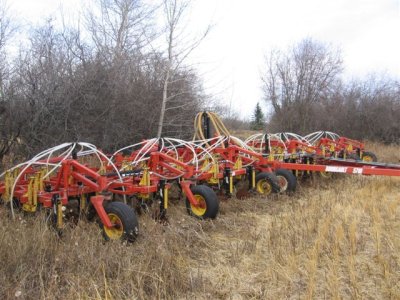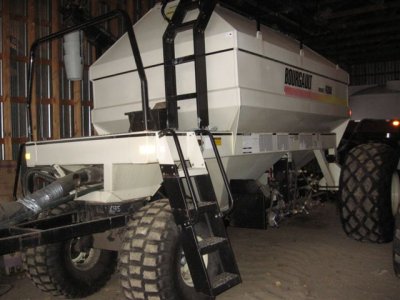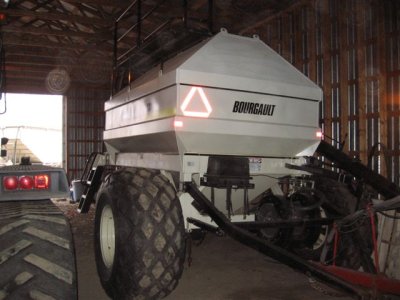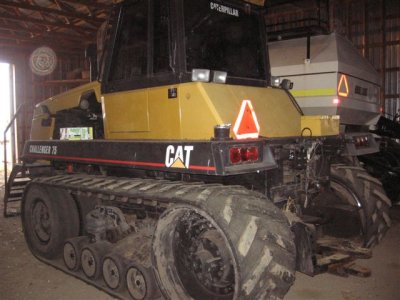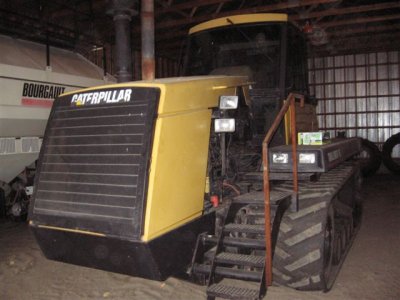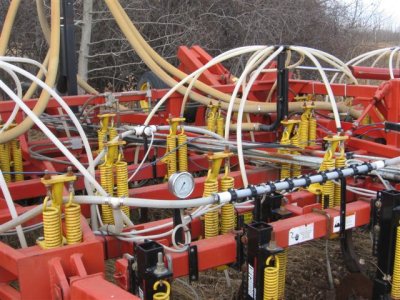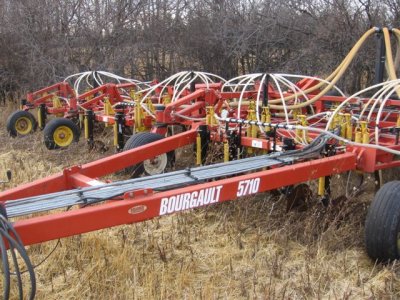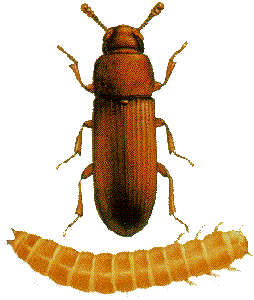You are using an out of date browser. It may not display this or other websites correctly.
You should upgrade or use an alternative browser.
You should upgrade or use an alternative browser.
Farmer talk
- Thread starter underdog
- Start date
- Thread starter
- #922
underdog
Active VIP Member
Farm Tech Conference: HomeThanks for the info. Registering today.Farm tech?? When and where??
Due to variable rate technology I have the following for sale.
Cat75 tractor - 325hp, approximately 7000 hours. Meticulously maintained by Cat mechanic.
Bourgualt 5710 - 54ft. - Single shoot with midrow banders running liquid Fertilizer. Have new boots to install, many spare parts.
Bourgault 4350 - tank. 3 tanks, middle tank has dual clutches, dual fans, all tank bearings done last year.
Shedded units since I've owned them.
Would like to sell as a pair if possible.
PM me if your interested.
Cat75 tractor - 325hp, approximately 7000 hours. Meticulously maintained by Cat mechanic.
Bourgualt 5710 - 54ft. - Single shoot with midrow banders running liquid Fertilizer. Have new boots to install, many spare parts.
Bourgault 4350 - tank. 3 tanks, middle tank has dual clutches, dual fans, all tank bearings done last year.
Shedded units since I've owned them.
Would like to sell as a pair if possible.
PM me if your interested.
Attachments
How was the track-type tractor for you? Will you be going to a wheel-type now?
Once you gone track you'll never go back!
Demoed a JD this fall, not sure if JD or Cat. Another note, if you're thinking controlled traffic the track tractors are easier to work with.
snopro
Active VIP Member
Just watched the evening news. Deere says they made $670 million in the last 3 months and expect to net $3.2 billion for the year. And why are we paying $625,000 for an all decked out combine?
byronkentgraham
Active VIP Member
Just watched the evening news. Deere says they made $670 million in the last 3 months and expect to net $3.2 billion for the year. And why are we paying $625,000 for an all decked out combine?
Because you're a dumb ass. You can get a big case for $430,000
snopro
Active VIP Member
Because you're a dumb ass. You can get a big case for $430,000[/QUOTE
Didn't actually mean I was buying one. Can't run red though.....I got work to do.
Once you gone track you'll never go back!
Demoed a JD this fall, not sure if JD or Cat. Another note, if you're thinking controlled traffic the track tractors are easier to work with.
Are you going to the Jd paralink????
Emailed you on the conference,
byronkentgraham
Active VIP Member
Because you're a dumb ass. You can get a big case for $430,000[/QUOTE
Didn't actually mean I was buying one. Can't run red though.....I got work to do.
If you get a John Deere you can stay busy for months on end....hours upon hours of unplugging that bad boy
Are you going to the Jd paralink????
Emailed you on the conference,
Check your email, JD conservapak; which is the paralink. Will be set up for liquid fertilizer.
- Thread starter
- #932
underdog
Active VIP Member
Alright boys, here's a mystery. Does anyone know what would cause this damage to wheat? The guys at the seed plant have never seen anything like it. Looks like whatever it was, was only after the inside of the kernel.
sent from a phone
sent from a phone
- Thread starter
- #935
underdog
Active VIP Member
Yes it was. Not sure if it was that way when we took it off the field or not.Was that in strored grain??
zeebs
Active VIP Member
What's everybodys take on the carbon credit programs
What a crock of chit! somebody was smokin some serious dope when they dreamt that up.
Im not trading any carbon credits Im burning mine!
sledhead_2002
Active VIP Member
- Joined
- Nov 27, 2008
- Messages
- 2,207
- Reaction score
- 454
- Location
- Winterpeg
- Website
- www.imperialseed.com
Alright boys, here's a mystery. Does anyone know what would cause this damage to wheat? The guys at the seed plant have never seen anything like it. Looks like whatever it was, was only after the inside of the kernel.
sent from a phone
Bug damage?
- Thread starter
- #938
underdog
Active VIP Member
That's my thoughts too. Just trying to find out what kind of bug so I can keep an eye out for it next year.Bug damage?
sledhead_2002
Active VIP Member
- Joined
- Nov 27, 2008
- Messages
- 2,207
- Reaction score
- 454
- Location
- Winterpeg
- Website
- www.imperialseed.com
| ||||||||||||||||||||||||||||||||||||
[FONT=times new roman, times][h=3]Grain and Bean Weevils[/h][/FONT]
Several types of weevils, including the rice, granary, maize and bean/pea weevils, can be encountered in the home. They are all pests of whole grain foods such as nuts, beans, cereals, fruits and seeds. The true weevils (rice, granary and maize weevils) have a long snout on the head. The rice weevil is about 3 mm long dark reddish brown, with four pale spots on the upper surface. The rice weevil can fly and is attracted to lights. The granary weevil is slightly larger (4 mm), of the same body style and entirely dark chestnut-brown. It cannot fly and is not attracted to lights. The maize weevil is also slightly larger than the rice weevil, and it is very dark reddish-brown or black with four yellowish spots. All of these weevils infest whole grain rice, barley, corn, wheat, popcorn, sunflower seeds, nuts, beans and bird seed. They will also attack hard cereal products such as macaroni, dry pet food, cereals and caked flour. The larvae are white, legless, and feed inside of the whole kernel or seed - hence they are rarely seen. Weevil damaged grains typically are hollow and have small, round emergence holes. The life cycle requires about 4 weeks and there may be three to five generations per year. The bean weevils are not true weevils; they are members of the closely related bean weevil family. Their body shape is more round than the rice, granary and maize weevils and they do not have the slender protruding snout of these true weevils. The common bean weevil is about 1/8 inch (3 mm) long with the upper surface mottled shades of gray. These feed on dried beans, leaving perfectly round holes in the beans. Very often, beans are harvested from the garden which look perfectly good. However, there can be been weevil larvae present inside. These larvae can continue to develop while the beans are in storage, with adults emerging during winter. Many a housekeeper has been dismayed to find a good supply of beans ruined by this insect. Heating the beans to 130 degrees F for 1/2 hour prior to storage will kill any larvae present and arrest any further development. A small number of dried larvae in the beans does not constitute any hazard to health. Integrated Pantry Weevil Management Purchase susceptible foodstuffs in quantities that can be used in a short time: 2-4 months, if possible. When purchasing packaged food, be certain the containers are not broken or unsealed and that there are no signs of infestation. Check the packages for freshness dates. Once food is in the home, use older packages before newer ones, and opened ones before unopened ones. Storing dried foods in a freezer will prevent insect development. Keep food storage and preparation areas clean at all times; spilled and exposed food attracts insects. If granary, rice or maize weevils are found in the kitchen, a search of all possible food sources should uncover the source of infestation. Disposal of infested grains and a thorough cleanup of the area should eliminate them. For bean weevil control, all that is required is to remove the infested beans and clean up the storage area. This pest does not infest as wide a range of stored goods and an insecticide is not recommended. [FONT=times new roman, times] [/FONT] |
- Thread starter
- #940
Similar threads
- Replies
- 785
- Views
- 77K



